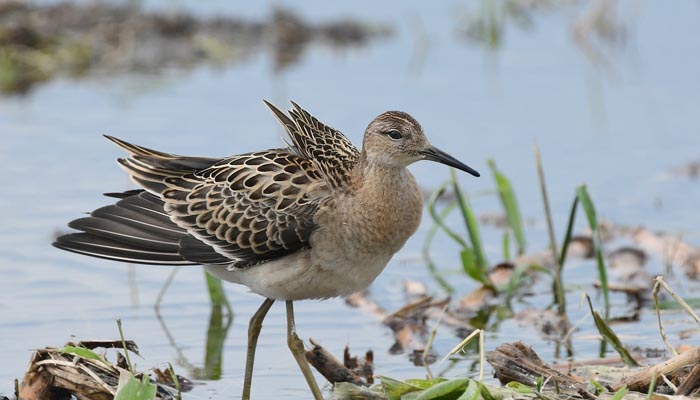
English: Ruff
Russian: Турухтан
Mongolian: Ноцоо ноололдой
German: Kampflaufer
French: Combattant varie
Japanese: エリマキシギ (Erimaki-shigi)
♂ Body length:
29-32 cm, wing span: 54-60 cm.
♀
Body length: 22-26 cm, wing span: 46-49 cm
Not
a rare vagrant but a common European breeder, treated here to facilitate
comparison with some similar-looking species. Breeds on taiga bogs, in marshes
and pools on mountainside and tundra, and in wet grass meadows at lakesides or
seashores. Summer visitor, winters mainly in Africa; on passage and in winter
frequents marshes, shallow pools, estuaries, ploughed and stubble fields.
Usually seen as a few or in smaller parties, but in spring at favoured sites
can occur in very large flocks. ♂ ♂ display in communal lek on traditional
arenas, which ♀♀ visit for mating. Arena, commonly used by c. 5-20 ♂ ♂, open
grassy patch, often with bare soil on favourite spots, c. 1 m apart. Display
silent, involves wing-flutter, short jumps, crouching with ruff erected, brief
fluttering attack on rivals with bill, legs or wings, sudden erect stance, or
forward-bent stance with ruff raised and drooped wings and tail.
Identification:
Marked sexual size difference: ♂♂ (Ruffs) considerably larger than ♀♀ (Reeves).
Larged ♂♂ slightly bigger and bulkier-bodied than Redshank; smallest ♀♀ only
slightly larger-bodied than Dunlin (but with longer neck and legs).
Small-headed/large-bodied look, rather long neck (when not hunched), and
medium-length bill which, unlike some confusion species, is slightly curved,
give rather distinctive shape which is especially useful for identifying some
immatures or ♀ plumages that are otherwise confusingly variable in pattern,
bare-part colours and size. Frequent habit (shared only with Black-tailed
Godwit) of slightly raising mantle-feathers when feeding, appearing as loose,
pointed ‘crest’ at top of back. Wingbeats subtly deeper and slower than other
small or medium-sized waders, giving rather distinctive lazier flight action;
often long glides before alighting. Thin, indistinct light wing-bar but bold
white oval patch each side of uppertail. Bill and leg colour variable: some
non-breeding ♂♂ with bright orange bill-base and legs easily confused with
Redshank, but shape different, and upperparts largely scaly (with some coarse
bars at rear), not largely plain (with some fine barring and spotting).
- Adult
summer: Display-plumage of ♂ has erectable crest and ruff in variable
combinations of plain or coarsely barred balck, deep rufous, orange or white;
worn only in May-Jun and rarely seen away from breeding areas; bill, warty skin
on face, and legs usually orange. ♀ brown, variable mottled or boldly spotted
with black; typically, bill all dark but legs orange or dull red (rarely brown
or greyish-green).
- Adult
winter: Sexes similar except for size. Bare parts usually duller and darker. ♂
has no crest, ruff or bare skin on face (but pale feathering at bill-base).
Rather plain pale grey-brown, but some are more whitish on head and neck;
tertails and large scapulars diffusely pale-fringed or coarsely barred dark.
- Juvenile:
Like adult winter, but often stronger buff tinge below, and upperparts have
neat scaly pattern with solidly dark feather centres.